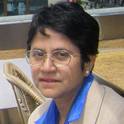Nawal El Saadawi's Woman at Point Zero1 is a novelistic rendering of an attempted interview between a psychiatrist and an Egyptian prostitute, Firdaus, at Qanatir Women's prison, awaiting capital punishment for murdering a pimp. Divided into three books, the first one is narrated by the psychiatrist. Narration of the second is taken up by Firdaus, as she relates her life story. Called a "pseudoautobiographical memoir", the Bildungsroman, moves from Firdaus's turbulent childhood to an abusive and severely exploited adulthood. It implicates in its trajectory not only parents and relatives but also the institutions of legal justice, religion2 and societal norms. The third section reverts back to the voice of the concerned psychiatrist as Firdaus is taken away by the authorities for execution .
Saadawi's text, a life-course model, autobiographical in intent: juxtaposes the two voices, the psychiatrist's and Firdaus's, as they interrelate and interpret each other. Though the narrative hands over the three sections to the two speaking voices, on close consideration the apparent divisions dissolve as the two voices seem to flow into each other, creating meaning through shifting positionalities. As the narrated Firdaus becomes the narrator, the psychiatrist switches from the subject, who narrates, to the object who stands being narrated, a shared womanhood the common denominator of this discourse, which in the second book acts through the voice of Firda us. This interchangeability makes for a shared space as they live through the other. They create a polyphonous voice that speaks this autobiographical "talk story" 3 through a trajectory of heterotopic spaces that map an "imaginative representation of place derived from experience or story" 4 holding within itself vignettes of private revelations while voicing its narrative through a comm unal female voice that is politically charged and ideologically empowered.
Sarah Herbe
